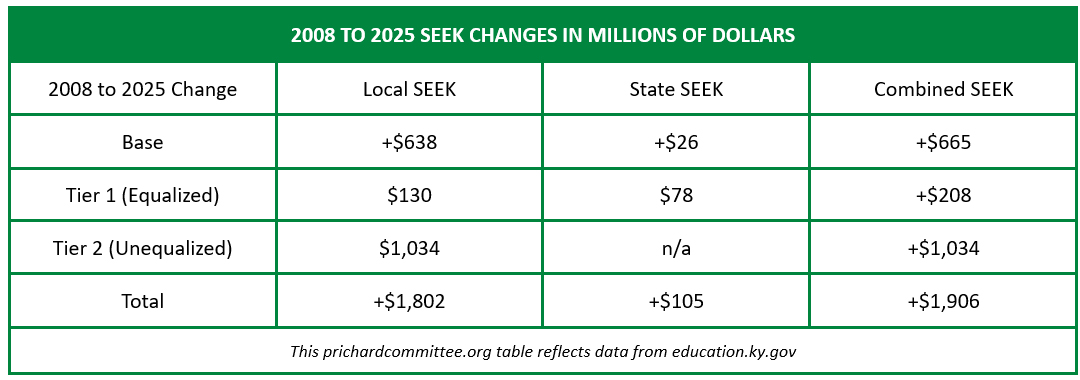Kentucky’s new School Report Cards are here! The new format for annual data on our schools has a friendlier layout and some important innovations, so I’m going to share what I saw in my first tour of the site.
When you arrive at the main landing page, you can choose any public school or district: my notes are based on looking at Toliver Elementary and Danville High School. Once you choose, you can scroll down and start seeing the news.
Clear charts of key data points
The main page is broken into five sections, each with a nice selection of charts showing important facts about each school. For example, here’s how the Overview section shows who attends Toliver:
Notice that the chart on economically disadvantaged students says data on free and reduced lunch eligibility is not available? Good charts can highlight questions about our schools, and I definitely want to ask about the missing data for Toliver. Further down the page, there are also short displays for Academic Performance, Educational Opportunity, Transition Readiness, and School Safety.

Quick links to more detailed data
Just to the right of each group of charts, there are three links to additional kinds of data. For example, for the Overview section, there’s more about students, more about faculty, staff and community, and more about access to technology. For Academic Performance, there’s more on assessment and performance, achievement gap and growth, and career and technical education.

Easy-to-read tables of information
Here’s how some of Toliver’s reading results are displayed, much easier to read than the 17-column version of the older report cards:
Great disaggregated KPREP data, including the “not” groups
The previous report card format did not include KPREP results for students who are not economically disadvantaged, do not have identified disabilities, and are not English learners. Those “not” results are key to understanding the gaps between better-served and worst-served groups, so it’s good to see them published again. The KPREP charts are also set up to show results for gifted students and for students who are and are not homeless, migrant, in foster care, or dependents of a member of the military. That information help us understand the strengths and experiences students bring with them and the effectiveness of school efforts to support each learner. (Sadly, the fully expanded list appears to be only for KPREP: data on KSCREEN, ACT, graduation, and other results are disaggregated much less.)
New looks at educational opportunity
To check out this sections, I switched over to Danville High School, looking at student work toward college and career readiness. This was great new information. For career and technical education, I learned that 94 DHS students enrolled to learn about marketing, and 29 completed a multi-course marketing “career pathway.” 57 took the first step on Project Lead The Way Engineering, and six completed that pathway. For advanced coursework, 403 students took AP courses, 204 took AP tests, and 45% of the test-takers had at least one score that qualified them for college credit (quick multiplication: that’s 108 students). There was plenty more to explore, including detail on visual and performing arts, health and physical education, and world languages.
These most recent trends show Kentucky is moving toward a better-educated adult population, with good reason to expect that to add strength to our economy and richness to all aspects of our civic life. They also show that we need to continue and accelerate our growth in attainment, with particular attention to groups who are not sharing fully in that growth, including Black non-Hispanic students and students with low-incomes.
Some Openings for Improvement
While admiring the innovations just mentioned, I do want to note some places where I thought the design could be stronger:
- The “not” groups could be included in more charts.
- Graduation rates could be easier to find: they’re under the second tab for the academic readiness link in the Transition Readiness section.
- The “Number of Instructional Minutes Students Receive per Week in Arts” could be better explained. For Danville High, the report shows 1,200 minutes per week in visual arts. That can’t mean that all students spend 20 hours in art classes. Does it mean there are four hour-long courses offered each term?
- Graduates reaching academic and/or career readiness benchmarks could be shown clearly. I could only find a “readiness count” that seems to include both graduates meeting benchmarks and English learner graduates attaining English Language proficiency. I know the new Transition Indicator reflects both kinds of data, but the detailed charts could show us those counts separately before combining them.
- A site map would be a great addition. There are five main sections with thirteen links to more detail, and many of those links lead to multiple tabs that each have several charts. A map would make this wide array of information easier to navigate.
- A “data not available” message appeared almost every time I clicked a new link. Often, that message was replaced in a few seconds by helpful information. If the data can’t be displayed instantly, it might be helpful to have replace “not available” with “being located,” so users don’t leave the page too quickly.
Overall, these new School Report Cards are a great step up in data access for the public. There’s room for further improvement, but first this project deserves a round of public applause. I recommend that every Kentuckian use it heavily to learn more about students, schools, and results in our communities.












